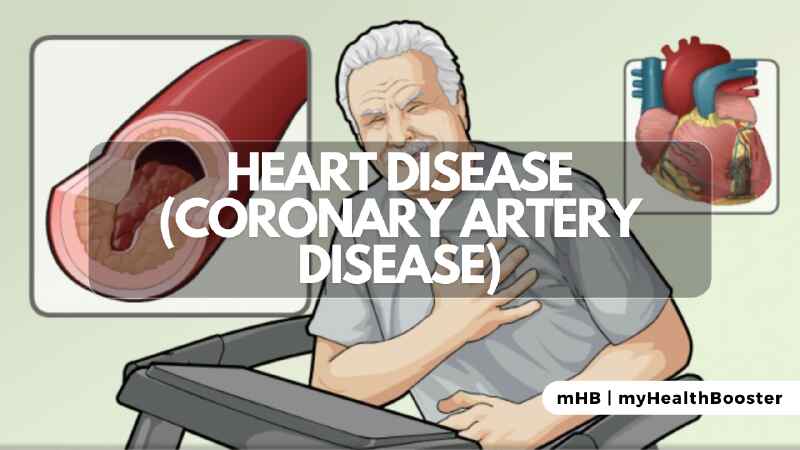Heart disease, medically known as coronary artery disease (CAD), affects millions of individuals worldwide. This condition arises when coronary arteries, responsible for supplying the heart with oxygenated blood, become narrowed or blocked. This article explores the causes, risk factors, symptoms, diagnosis, and treatment options associated with heart disease.
Understanding Heart Disease
The heart, a vital muscle, requires an uninterrupted blood supply for optimal function. Coronary arteries, originating from the aorta, play a crucial role in delivering oxygen to the heart. When these arteries narrow, restricting blood flow, the heart may experience pain, known as angina. In severe cases, a complete blockage can lead to a heart attack, resulting in the death of part of the heart muscle.
Causes of Heart Disease
Lifestyle factors significantly contribute to heart disease, with smoking, poorly controlled hypertension, and diabetes causing inflammation in the coronary arteries. Over time, cholesterol accumulates, forming plaque that narrows the arteries. Plaque rupture can lead to blood clot formation, blocking the artery and causing a heart attack. Risk factors include a family history of heart issues, obesity, and a history of high cholesterol.
Warning Signs and Symptoms
Classic angina symptoms include chest pain, pressure, or heaviness, often radiating to the left arm or jaw. Shortness of breath, sweating, and nausea may accompany these symptoms, worsening with activity and improving with rest. Unstable angina can occur at rest and may not respond quickly to treatment.
Diagnosis of Heart Disease
Primary care practitioners play a crucial role in diagnosing and managing heart disease. Initial evaluations involve understanding the patient’s history and symptoms. Various tests, such as electrocardiograms (EKG), stress tests, echocardiography, nuclear imaging, and cardiac CT or MRI scans, may be employed. Invasive procedures like cardiac catheterization help confirm diagnoses and guide treatment decisions.
Treatment Options
Treatment goals aim to enhance both quantity and quality of life. Prevention is key and involves lifestyle modifications, such as regular exercise, smoking cessation, and adopting a heart-healthy diet. Medications, including antiplatelet drugs like aspirin, beta-blockers, calcium channel blockers, and nitrates, may be prescribed. Invasive interventions like angioplasty or coronary artery bypass surgery may be considered in severe cases.
Prevention of Heart Disease
Preventing heart disease involves lifelong commitments to controlling blood pressure, cholesterol levels, quitting smoking, and managing diabetes. New guidelines emphasize the role of statin medications in reducing cholesterol levels, with the focus on individualized treatment goals.
Prognosis and Statistics
Approximately 15.5 million people in the United States have coronary artery disease, with 1.5 million experiencing acute myocardial infarctions annually. Early diagnosis and treatment significantly improve prognosis, and public awareness about recognizing and promptly addressing chest pain can save lives.
Summary
Heart disease is a prevalent and serious condition, but with early detection and comprehensive management, individuals can lead fulfilling lives. Understanding the risk factors, recognizing symptoms, and adopting a heart-healthy lifestyle are vital steps in preventing and managing heart disease.
References
- Arnett, D. K., et al. “AHA/ACC/HHS Strategies to Enhance Application of Clinical Practice Guidelines in Patients with Cardiovascular Disease and Comorbid Conditions.” Circulation 130.18 (2014): 1662-1667.
- Bamberg, F., et al. “Meta-analysis and systematic review of the long-term predictive value of assessment of coronary atherosclerosis by contrast-enhanced coronary computed tomography angiography.” Journal of the American College of Cardiology 57.24 (2011): 2426-2436.
- Centers for Disease Control and Prevention. “Coronary Artery Disease (CAD).”
- Centers for Disease Control and Prevention. “Heart Attack Signs and Symptoms.”
- Centers for Disease Control and Prevention. “Health, United States, 2015: With Special Feature on Racial and Ethnic Health Disparities.”
- Centers for Disease Control and Prevention. “Leading Causes of Death.”
- Greenland, P., et al. “2010 ACCF/AHA guideline for assessment of cardiovascular risk in asymptomatic adults: a report of the American College of Cardiology Foundation/American Heart Association Task Force on Practice Guidelines.” Journal of the American College of Cardiology 56.25 (2010): e50-e103.
- Kasper, D.L., et al., eds. Harrison’s Principles of Internal Medicine, 19th Ed. United States: McGraw-Hill Education, 2015.
- Stone, N. J., et al. “2013 ACC/AHA Guideline on the Treatment of Blood Cholesterol to Reduce Atherosclerotic Cardiovascular Risk in Adults: A Report of the American College of Cardiology/American Heart Association Task Force on Practice Guidelines.” Journal of the American College of Cardiology 7 Nov. 2013.
